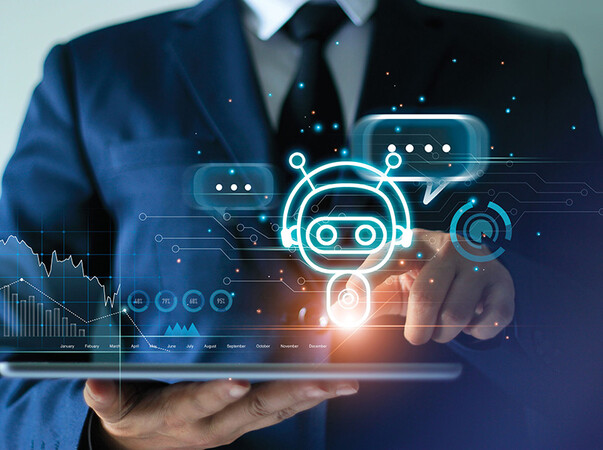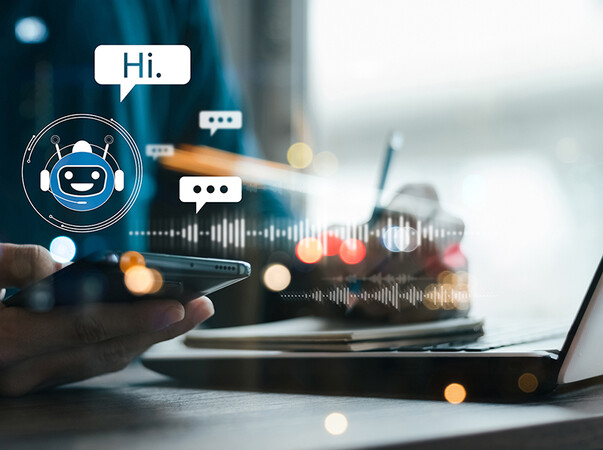Chatbots as digital service employees
They are available around the clock, answer customer queries and make online appointments. Chatbots on websites can relieve companies from the lift sector of a great deal of work in terms of communication and service.
Companies offer their customers a customer service that is always accessible with chatbots: almost two-thirds of B2C companies in Europe are already using chatbots on their websites. This was the result of the 2021 EOS chatbot study during which over 2,800 companies were surveyed from 14 countries. The most common tasks of digital assistants are initial contact with customers (97 percent), the field of customer service (51 percent) and product advice (39 percent).
But what in fact is a chatbot – and what tasks can it assume? The term is obviously a combination of the words "chat" and "robot". Basically, a chatbot is a virtual assistant that can engage in user interactions via text or audio systems. One of the best known examples is ChatGPT.
 Photo: © Tippapatt/iStock.com
Photo: © Tippapatt/iStock.comOn many company homepages, questions can already be inserted in a chat field, upon which a chatbot automatically requests more information to provide the customer with additional assistance. For instance, chatbots can answer questions, make appointments or put customers into contact with an appropriate human service employee. This saves actual employees a great deal of time since it ensures that all the important information has already been asked for, allowing them to begin directly with a search for the solution.
Simple chatbots only have a small repertoire of ready-made answers to the most frequent questions. By contrast, more highly developed chatbots deploy artificial intelligence (AI) to find individual solutions. Furthermore, chatbots are also in a position to reply to messages digitally and can offer customers a return call or reply by mail and messenger systems.
Faster than human colleagues
The use of chatbots is not only of interest for large companies but above all also for small businesses. This is because the burden on small teams in particular is noticeably relieved, as a result of which they gain valuable time for daily business. Consequently, the basic advantages of chatbots apply to all company sizes: routine tasks, such as answering customer queries, are automated and accelerated.
Chatbots have proved to be very much faster than their human colleagues in answering questions. The latter are simultaneously more satisfied with their workplace since they are no longer subjected to repeatedly answering queries and can better concentrate on more complex questions. At the same time, customers regard chatbots as a special service: whereas in many companies no questions are answered outside of business hours, chatbots provide assistance around the clock. But naturally also if all other colleagues are already in discussions or unavailable.
Companies can usually take on the "feeding" of the chatbots with company-specific questions and corresponding replies themselves without any programming knowledge. Creating buttons with optional selection options is often possible with just a few clicks. As a result, customers can later quickly find the best possible answer, the matching product or the desired service. Some chatbots also offer the option of sending documents on request, such as catalogues, brochures or invoices.
Try out free test offers
 Photo: © Thapana Onphalai/iStock.com
Photo: © Thapana Onphalai/iStock.comThe costs of the various chatbots vary greatly: depending on the convenience and scope of performance, there are free basic offers or very comprehensive packages that cost a four-figure sum monthly.
Consequently, companies should consider very carefully in advance what tasks the digital assistant is to assume in order to deploy a chatbot precisely and achieve the best value for money. The different functional ranges make sense in relation to the area of deployment and work processes. Several providers also permit free test phases, which allow the chatbots to undergo a thorough examination in advance.
Overview of selected chatbots
| Chatbot | Botcamp.ai | Kiko | Melibo | moinAI | Userlike |
| Description | Individual chatbot solutions with AI-supported language comprehension. GDPR-compliant | Chatbot solution, modified for individual requirements and needs. GDPR-compliant | Automated replies to customer queries with hybrid support tool: conversational AI, ticket centre & live chat. GDPR-compliant | Customer communication with artificial intelligence and AI chatbots, GDPR-compliant | Multichannel messaging, automation and chatbot functions, including central AI-supported knowledge base. GDPR-compliant |
| Prices | PPackage “Simple” from € 499/month + initial costs | Setup prices between € 500 and 5,000 plus variable costs | Package “Essential” from € 750/month | Package “Essential” from € 790/month + initial costs | Package “Corporate” from € 256/month |
| Internet | botcamp.ai | kiko.bot | melibo.de | moin.ai | userlike.com |
As of: 23.08.2023. All information subject to correction.
Checklist: the ideal chatbot for customer service and communication - Develop concept: What tasks are the chatbot to assume, e.g. in the fields customer service, marketing or distribution? How can employees be best supported? Are the chatbots to be multilingual?
- Check interfaces: Are other software products to be connected to the chatbot, for example, an online appointment planner, invoice despatch, catalogues or online shops? If so, are the existing software products equipped with interfaces for chatbots?
- Analyse equipment: What soft- and hardware equipment does the provider says is needed to use the chatbot? What technical expertise should the employees possess?
- Determine budget: What one-off and monthly costs are to be expected - also for any additional hard- and software needed?
- Choose chatbot: With what chatbot or provider can the company’s targets be best achieved at the lowest cost?
- Determine responsibilities: Who takes on setting up the chatbot on the technical side and its content? Who is responsible for later optimisations during ongoing operation?
- Analyse successes: Use statistical analyses, tracking results or internal analyses to evaluate the success of your chatbot and continually improve its accuracy.
- Observe laws: Always adhere to all legal requirements during online activities, such as the GDPR, copyright and the (German) Telemedia Act.






















Write a comment